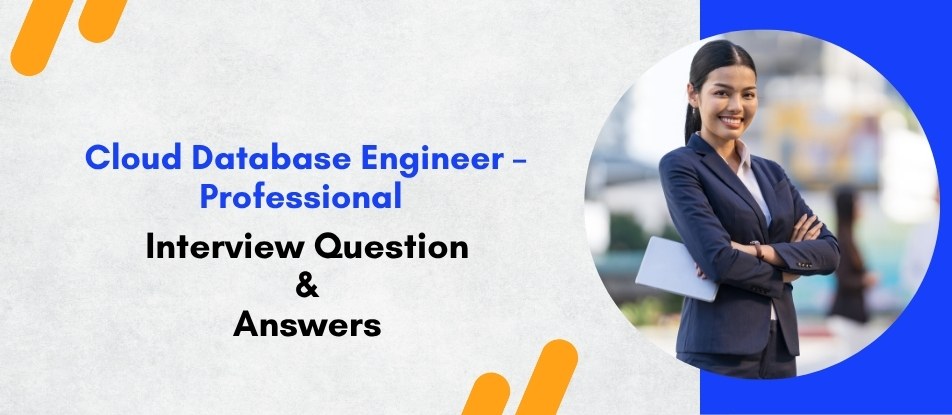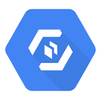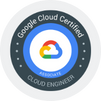
The Cloud Database Engineer – Professional course is designed for IT professionals aiming to master cloud-based database architecture, deployment, and administration. This program covers cloud-native database services, replication, performance optimization, security compliance, and disaster recovery strategies. Learners gain hands-on expertise with multi-region setups and automation tools across platforms like AWS, Azure, and GCP. Ideal for database engineers, it prepares candidates for advanced roles in managing enterprise-grade cloud data infrastructures.
Cloud Database Engineer Training Interview Questions Answers - For Intermediate
1. What is a database connection pool, and why is it important in the cloud?
A database connection pool is a cache of database connections maintained so they can be reused for future requests. In cloud environments, it helps manage resources efficiently by limiting the number of simultaneous connections, reducing latency, and improving application performance, especially under variable loads.
2. How does autoscaling affect cloud-based databases?
Autoscaling automatically adjusts database resources like compute and storage based on demand. This ensures consistent performance during traffic spikes and optimizes costs during periods of low usage. It enables applications to remain responsive while minimizing manual intervention and overprovisioning.
3. What is a serverless database, and when is it ideal to use?
A serverless database automatically handles provisioning, scaling, and maintenance, allowing users to focus solely on application logic. It is ideal for unpredictable workloads or applications with sporadic usage patterns, as it charges based on actual consumption rather than pre-allocated capacity.
4. What factors influence the choice between SQL and NoSQL in cloud architectures?
The choice depends on data structure, consistency requirements, scalability, and application goals. SQL is preferred for structured data and complex transactions, while NoSQL suits flexible schemas, high-velocity data, and scenarios demanding horizontal scalability and rapid development.
5. How do cloud-native tools assist in database migration?
Cloud providers offer native tools like AWS Database Migration Service, Azure Database Migration Service, and Google Database Migration Service. These tools help in schema conversion, continuous data replication, and downtime minimization, simplifying the migration process and ensuring data integrity.
6. What is the significance of database sharding in cloud environments?
Database sharding divides large datasets into smaller, more manageable pieces called shards, which are distributed across different servers. In cloud environments, sharding improves scalability, performance, and fault isolation, making it easier to handle large-scale applications.
7. How do cloud SLAs impact database service selection?
Service Level Agreements (SLAs) define the expected uptime, performance, and support levels. When selecting a cloud database service, engineers must consider SLAs to align with business continuity goals, compliance requirements, and the criticality of the data being managed.
8. What is the importance of versioning in cloud database backups?
Versioning ensures that multiple historical copies of data are retained, enabling precise point-in-time recovery. This is especially important in cases of accidental deletion, data corruption, or malicious attacks, allowing rollback to a known good state with minimal data loss.
9. How can latency be reduced in cloud databases?
Reducing latency involves deploying databases in regions closer to users, enabling read replicas, optimizing indexing and queries, and using caching layers. Additionally, choosing appropriate storage types and ensuring network efficiency plays a significant role in lowering data access times.
10. What is data partitioning, and how is it used in cloud databases?
Data partitioning divides a database into distinct segments based on criteria such as range, list, or hash values. In the cloud, partitioning improves query performance and resource management by spreading the workload and reducing contention on storage and compute resources.
11. Why is database observability important in cloud operations?
Database observability provides insight into health, performance, and usage trends through logging, metrics, and tracing. It enables proactive issue detection, improves system reliability, and supports optimization efforts, which are essential in dynamic cloud environments.
12. What are hybrid cloud database solutions, and when are they used?
Hybrid cloud databases operate across on-premises and cloud environments, allowing data to be distributed or synchronized as needed. They are used when regulatory, latency, or infrastructure constraints require partial retention of systems on-premise while leveraging cloud capabilities.
13. How do retention policies work in cloud databases?
Retention policies define how long data is stored before it is deleted or archived. These policies help manage storage costs, maintain compliance, and reduce data clutter, with cloud platforms often offering customizable settings for different types of data and use cases.
14. What is a cloud-native schema design approach?
Cloud-native schema design focuses on scalability, flexibility, and distributed architecture. It avoids rigid normalization when unnecessary and favors denormalization or NoSQL models depending on performance needs, ensuring the design supports high availability and growth across cloud infrastructure.
15. How do cost management strategies apply to cloud database usage?
Cost management involves selecting the right pricing models, scaling configurations, and storage types. Monitoring usage, implementing lifecycle policies for old data, and reserving instances for predictable workloads are common practices that help organizations stay within budget and maximize return on investment.
Cloud Database Engineer Training Interview Questions Answers - For Advanced
1. How do latency and throughput affect performance in distributed cloud database systems?
Latency refers to the time taken for a single operation (like a query or write) to complete, whereas throughput measures how many operations a system can handle within a specific time frame. In distributed cloud databases, minimizing latency is critical for real-time applications, while maximizing throughput is essential for large-scale data processing. Network delays, disk I/O, and replication strategies can significantly impact both metrics. Engineers must carefully design data partitioning, indexing strategies, and caching layers to balance low latency with high throughput. Choosing the correct instance types, regions, and read/write replicas also contributes to optimizing these performance parameters.
2. What are the key components of a disaster recovery (DR) strategy for cloud databases?
A robust DR strategy for cloud databases involves automated backups, geographic redundancy, clearly defined recovery time objectives (RTOs) and recovery point objectives (RPOs), and failover mechanisms. The architecture must include cross-region replication to protect against regional outages. Backup validation, regular disaster recovery drills, and documented runbooks ensure preparedness. Point-in-time recovery features allow restoration to a specific state before data loss or corruption. Cloud-native services often provide DR automation capabilities, reducing human error and enabling quick restoration with minimal downtime and data loss.
3. How do data governance policies apply to cloud database environments?
Data governance in the cloud requires clear policies around data classification, ownership, access, and lifecycle management. Cloud database environments must enforce these through tagging, access control policies, and encryption standards. Data lineage tools help trace data origins, transformations, and usage, ensuring transparency and compliance. Additionally, retention and archival policies must align with regulatory requirements. Effective governance includes audits, automated policy enforcement, metadata management, and continuous monitoring to prevent unauthorized access and maintain accountability.
4. What is the role of AI and machine learning in managing cloud databases?
AI and machine learning enhance cloud database management through predictive analytics, anomaly detection, and automated optimization. These technologies can forecast workload patterns, recommend index strategies, detect security threats, and predict hardware failures. Many cloud platforms now offer AI-driven insights into query performance and cost optimization. AI can also assist in automating schema changes, capacity planning, and self-healing operations. This reduces administrative burden, improves performance, and enables more intelligent resource allocation.
5. How do cloud-native databases support microservices and containerized environments?
Cloud-native databases are designed to integrate with microservices and containers by offering lightweight, scalable, and API-driven services. They support dynamic provisioning, stateless interactions, and high availability, making them suitable for Kubernetes and container orchestration platforms. Stateful workloads are managed through persistent volumes, and databases are accessed via service endpoints. Features like dynamic scaling, automated failover, and service discovery simplify their use in ephemeral and elastic environments. Cloud-native databases also support declarative infrastructure, enabling reproducible and automated deployments alongside application code.
6. How are zero-downtime database deployments achieved in cloud environments?
Zero-downtime deployments are accomplished through techniques like blue-green deployments, rolling updates, and database replication. Schema changes must be backward compatible to avoid disruptions during version transitions. Traffic shifting tools and feature flags help manage gradual rollouts and rollback scenarios. Cloud platforms often provide tools for transactional replication and version control, allowing smooth transitions between database states. Moreover, asynchronous replication and queuing mechanisms ensure that operations continue during deployment phases without affecting user experience.
7. What are the best practices for database observability in serverless architectures?
In serverless environments, observability must account for ephemeral compute resources and dynamic scaling. Engineers should implement centralized logging, distributed tracing, and real-time monitoring to track database interactions. Metrics such as latency, throughput, error rates, and cold start durations are critical. Cloud-native monitoring tools must be integrated with alerts and dashboards to visualize performance trends. Given the decoupled nature of serverless systems, it is also important to instrument API gateways, event sources, and data storage layers to provide end-to-end visibility.
8. How is compliance with data sovereignty laws maintained in global cloud databases?
Compliance with data sovereignty laws is achieved by restricting data storage and processing to specific geographic locations. Cloud providers allow customers to choose regions or availability zones to ensure compliance with jurisdictional regulations. Engineers must ensure that replication, backups, and disaster recovery configurations do not transfer data across borders without legal safeguards. Encryption and key management services localized to specific regions further support data sovereignty. Regular audits and integration with compliance frameworks like ISO, GDPR, or HIPAA help organizations adhere to country-specific legal requirements.
9. What are some advanced techniques for query optimization in distributed cloud databases?
Advanced optimization techniques include query parallelization, predicate pushdown, and materialized views. Engineers also leverage statistics gathering, execution plan analysis, and query rewriting to improve efficiency. In distributed systems, minimizing cross-node data transfer and exploiting data locality is crucial. Using denormalization, data co-location, and partition pruning can significantly reduce query time. Adaptive caching and result set reuse strategies also help improve repeated query performance in high-traffic environments.
10. How can cost controls be enforced in multi-tenant cloud database environments?
Cost control in multi-tenant environments requires resource isolation, usage metering, and chargeback models. Engineers must monitor and limit compute, storage, and network consumption per tenant using quotas and policies. Multi-tenant databases can be architected with shared schemas or isolated instances, depending on security and performance needs. Cloud-native tools provide cost visibility dashboards and alerts to identify anomalies or excessive usage. Auto-scaling must be configured with usage thresholds, and idle resources should be automatically de-provisioned to avoid wastage.
11. What are the trade-offs between using fully managed vs. self-managed cloud database services?
Fully managed services offer ease of use, automatic updates, scaling, and built-in monitoring, making them ideal for teams that prioritize agility and operational efficiency. However, they can be more costly and may limit control over low-level configurations. Self-managed services provide greater customization and control but require skilled personnel for maintenance, monitoring, and scaling. The choice depends on workload complexity, compliance needs, and available engineering resources. Enterprises often use a hybrid approach, leveraging managed services for common workloads and self-managed setups for specialized use cases.
12. How do read replicas improve performance and reliability in cloud databases?
Read replicas offload read-heavy traffic from the primary instance, thereby improving performance and availability. They enable horizontal scaling for read operations and allow geographic distribution of read requests to reduce latency for global users. In case of primary instance failure, replicas can be promoted to take over, enhancing reliability. They also support reporting and analytics workloads without affecting transactional performance. However, engineers must manage replication lag and ensure that applications can handle eventual consistency where necessary.
13. What considerations are necessary when implementing encryption in cloud databases?
Implementing encryption requires decisions about data-at-rest, in-transit, and in-use protection. Engineers must select strong encryption algorithms and manage encryption keys securely, often using cloud-native Key Management Services (KMS). Transparent Data Encryption (TDE) simplifies at-rest protection, while SSL/TLS secures transit channels. For highly sensitive data, field-level encryption or tokenization is also implemented. Encryption impacts performance and must be tested thoroughly. Access to encrypted data must be logged and controlled using identity and access management policies.
14. What are the implications of network architecture on cloud database performance?
Network latency, bandwidth, and security configurations significantly impact cloud database performance. Poorly designed network paths between application and database tiers can result in high query response times. Engineers must consider VPC peering, private endpoints, and proximity placement groups to optimize traffic flow. Load balancers, NAT gateways, and firewall rules must be configured to prevent bottlenecks. Moreover, multi-region architectures require careful planning to avoid excessive cross-region latency and data transfer costs, ensuring traffic is routed efficiently and securely.
15. How can AI/ML pipelines be integrated with cloud databases for real-time inference?
Integrating AI/ML pipelines with cloud databases involves streaming data ingestion, model serving, and inference APIs. Data is typically fed into the model from cloud databases using ETL or real-time messaging platforms. The results can be stored back into the database or streamed to downstream services. Engineers must ensure data consistency, version control for models, and low-latency processing to support real-time use cases. Monitoring and retraining strategies must also be in place to maintain model accuracy and adapt to changing data trends.
Course Schedule
| Dec, 2025 | Weekdays | Mon-Fri | Enquire Now |
| Weekend | Sat-Sun | Enquire Now | |
| Jan, 2026 | Weekdays | Mon-Fri | Enquire Now |
| Weekend | Sat-Sun | Enquire Now |
Related Courses
Related Articles
- How Abaqus Online Training Helps Engineers Build Expertise?
- How Kronos Workforce Dimensions Training Builds Real Skills
- SAP FICO tutorial for beginners
- Upgrade Your Skills with AutoCAD P&ID Online Training for Career Growth
- SAP Financial Contract Accounting (FI-CA) Explained: Billing, Invoicing, and Revenue Management
Related Interview
Related FAQ's
- Instructor-led Live Online Interactive Training
- Project Based Customized Learning
- Fast Track Training Program
- Self-paced learning
- In one-on-one training, you have the flexibility to choose the days, timings, and duration according to your preferences.
- We create a personalized training calendar based on your chosen schedule.
- Complete Live Online Interactive Training of the Course
- After Training Recorded Videos
- Session-wise Learning Material and notes for lifetime
- Practical & Assignments exercises
- Global Course Completion Certificate
- 24x7 after Training Support













 Join our Live Instructor-Led online classes delivered by industry experts
Join our Live Instructor-Led online classes delivered by industry experts